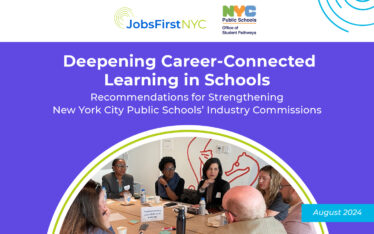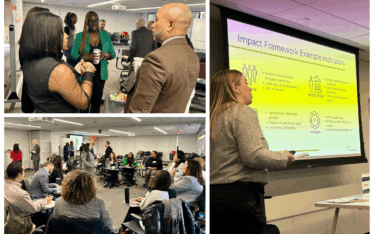In the last few months, we have witnessed a welcomed change in New York City to name and scale a vision for creating career-connected learning and pathways for all our students in City schools. These changes closely align with our work through the Transfer 2 Career Collaborative to embed career pathways in schools via structural partnerships between high schools and workforce training organizations. To further strengthen our efforts to reimagine career development in schools, we recently launched a CDOS Institute for Workforce Practitioners with the goal of increasing quality work-based learning in schools. Below, we share more about how our vision is intersecting with the direction New York City is moving in.
Some exciting recent announcements from NYC leadership that indicates positive changes towards ensuring our young adults can achieve economic mobility includes:
- Commitment to long-term economic security for students: In March 2022, Chancellor David Banks announced that there is a New North Star: education will lead to a rewarding career and long-term economic security for every student. The NYC Department of Education’s aim is for each student’s learning journey to be more relevant, contextualized, engaging, and career-connected. The strategy is to create “career-connected learning and pathways for all our students to help activate their passion and sense of purpose.”1
- Commitment to building an ecosystem that supports career pathways: As of January 2022, a new leadership position “Chief of Student Pathways” was created in the NYC Department of Education (DOE) to build the ecosystem and ensure that all students have access to career pathways in high school. Chancellor David Banks announced that Jade Grieve will be leading this work that will result in all students graduating high school with a “strong plan and a headstart on a pathway to the middle class.” This Fall, the NYC DOE will “pilot models that establish new career pathways […] and develop teachers and school leaders to support students in developing their passions.” Students will also “graduate financially literate” and be “positive forces for change in their communities and our city.”
- Blueprint for New York City Economic Recovery: Mayor Adams recently shared his Blueprint for New York City’s Economic Recovery, which includes a vision for young people graduating high school on career paths. The mayor shared plans to “develop talent through expanding internship programs, collaborating with industries that support BIPOC entrepreneurs and talent, and developing new programs that focus on training New Yorkers for roles that require a bachelor’s degree or less.” Additionally, the Blueprint noted the City’s intention of “partnering with industry on defining new career pathways — both longer-term K-12 and postsecondary pipelines and shorter-term training and certification programs that can help upskill or re-skill workers.” Lastly, he shares a strategy to expand “bridge programs, which provide hybrid educational programs with a career focus, helping New Yorkers in the job and career search” to increase necessary language and numeracy skills.2
- Increase in the number of young people that can participate in Summer Youth Employment (SYEP) Program: After a couple of years of SYEP cuts and cancellation threats, Mayor Adams announced that the student spots in SYEP will be increased from 75,000 to 100,000. Though this will not make universally available for all young adults (an analysis suggests we would need 150,000 spots to serve all eligible young adults who want a summer job), this increase will allow more young people a summer experience that can be life changing.
With this aligned vision, there is reason for hope for a transformed system that best serves young adults. In 2018, JobsFirstNYC began efforts to implement work-based learning in schools across the NYC system. We believe that systemic change requires real collaboration – all partners coming together with an understanding of the expertise they bring and a commitment to serving all young people, particularly those most at-risk of becoming out-of-school and out-of-work. We have engaged our base – our high-quality workforce development partners – in this effort to bring their work-based learning and skills training, partner expertise, and employer engagement expertise into the high school system.
To place our young adults on a path to economic mobility, we believe that all students should have access to rigorous work-based learning (WBL) opportunities as part of their high school curriculum. As such, students should be granted credit for these opportunities, and these experiences should count towards their high school diploma requirements. The New York State Career Development and Occupational Studies credential (CDOS) is an approved pathway through which students are able to receive credit and an additional pathway to a high school diploma. It is a commencement credential of readiness for entry-level employment that indicates a student has met foundational career readiness standards and has developed key professional skills.
Through CDOS, students can participate in career development while they are still enrolled in high school, and achieve the goals of:
- Meeting high school credit and degree requirements
- Building skills and earning industry credentials
- Supporting transition to postsecondary opportunities.
In early March, JobsFirstNYC launched a first-of-its-kind CDOS Institute for Workforce Practitioners. This free capacity-building series will support workforce organizations, including community-based organizations, non-profits, intermediaries, and higher education institutions, to align their job readiness, sector skills training curriculum and work-based learning opportunities to high school credited CDOS standards. All have gained entry into a diverse and powerful community of practice working to adapt curriculum for a high school audience, with the goal of offering career training, certificates, and credentials to high school students. In our inaugural cohort, we have 67 participants across 34 organizations participating.
Challenges persist at all levels to embed career pathways in schools. There is no centralized structure for supporting new school and workforce partnerships, requiring our partners to go school by school to broker new collaborations, and no clear, measurable standards for developing and maintaining the partnerships. CDOS could benefit from restructuring to make delivery easier. Existing teaching evaluations, seat time, school staffing and Regents exams continue to be a burden to change. Resources are limited and school budgets have very little flexibility. And our young adults need to juggle many things in their day, including paid work to support their families. However, the possibilities exist and interest is there on the part of young adults to participate in work-based learning and career development as part of schooling. If students can find ways to gain high school credit for their work-based learning experiences, including internships and jobs, they can meet multiple goals at once. And if we connect the education and workforce development sectors and ensure the high school academic experience is aligned to a student’s professional interests, we can better connect the dots for young people.
Our strategy to prepare all sides of the ecosystem – here with workforce development providers, and via other initiatives, with school leaders, teachers, counselors, city agencies, funders, and employers – is off and running. And with our North Star of economic mobility for all young adults being in line with the city’s new North Star, we continue to work towards all young adults leaving high school with a strong postsecondary plan, rooted in their interests, skills, and quality experiences.




